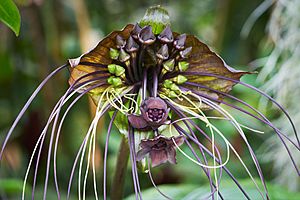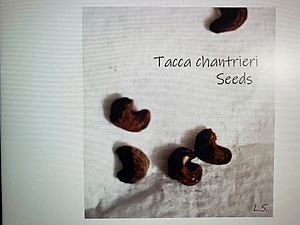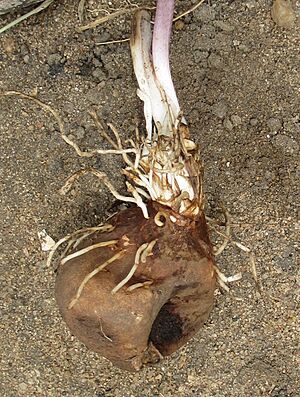Black bat flower facts for kids
Quick facts for kids Black bat flower |
|
|---|---|
 |
|
 |
|
| Seeds of T. chantrieri | |
| Scientific classification | |
| Genus: |
Tacca
|
| Species: |
chantrieri
|
| Synonyms | |
|
Schizocapsa breviscapa (Ostenf.) H.Limpr. |
|
The Black Bat Flower (scientific name: Tacca chantrieri) is a unique flowering plant. It belongs to the yam family, called Dioscoreaceae. This plant was first described in 1901 by Édouard André.
Tacca chantrieri grows naturally in Southeast Asia. It is often called the black bat flower because of its unusual shape and dark color. This plant has a special way of pollinating itself, mostly through self-pollination. The black bat flower thrives in warm, moist places, much like its original home. People have used it for a long time in traditional Chinese medicine for various health issues.
Contents
What Does the Bat Flower Look Like?
There are ten different types of plants in the Tacca group. Tacca chantrieri is known by many names, like bat flower, devil flower, or cat whiskers. It stands out because it has black flowers, which are quite rare.
The plant has large parts that look like wings, called bracts. These can be up to 12 inches (30 cm) wide. The plant itself can grow to be 20 to 40 inches (50–100 cm) tall. It also has long, thin parts that hang down, called bracteoles, which look like a bat's whiskers. These can be 8 to 10 inches (20–25 cm) long. Some scientists think these "whiskers" might even help the plant make its own food from sunlight.
Where Does the Bat Flower Grow?
The black bat flower is found across Southeast Asia. You can find it in places like Assam, Bangladesh, Cambodia, Southern China, Hainan, Laos, Malaysia, Myanmar, Thailand, Tibet, and Vietnam. It grows in more places than any other plant in its group.
However, the number of black bat flowers is decreasing. This is happening because too many are being collected, their natural homes are being destroyed, and forests are being broken up into smaller pieces.
How Does the Bat Flower Pollinate?
The black bat flower comes in dark colors like brown, purple, and sometimes even green. These colors usually attract insects that like decaying things, but that's not the case for this flower. Flies might fly into the flower, thinking there's something decaying inside. Light helps guide the flies through the flower's tunnel. But since the flower doesn't offer them any food, the flies try to leave.
It's very hard for insects to leave because of the flower's structure. The "helmet-like stamens" make it almost impossible for them to get out. Even though the plant puts a lot of energy into its fancy flowers, most of its seeds come from self-pollination. This means the plant pollinates itself, often before the flower even fully opens. This might happen because insects don't visit the flowers very often. Some people think the flower might have once had a bad smell to attract pollinators, or that it had a special pollinator that is now extinct.
Growing Your Own Bat Flower
The black bat flower blooms from April to July. If you grow one, you should not cut its flowering parts, or the flower will quickly die. The plant starts to bloom after it has grown at least two leaves. It can bloom up to 8 times in one growing season!
Growing black bat flowers is similar to growing Orchids. This plant is a geophyte, which means it has underground stems called rhizomes. These rhizomes prefer moist, tropical soil that is rich in nutrients. You can grow the black bat flower both outdoors in the ground or indoors as a houseplant. It grows best in areas with low to medium light.
These flowers usually don't have many problems with pests or diseases. However, gardeners should watch out for slugs and snails. If you keep the plant indoors, you need to make sure it has enough humidity. You can do this by misting it regularly with water. You can grow new bat flowers from its rhizomes, by dividing its tubers, or sometimes from seeds.
How People Use the Bat Flower
The black bat flower has many medicinal uses that have been part of Chinese medicine for a long time. The helpful parts are found in its rhizomes, which are like its root stalks.
The rhizomes of Tacca chantrieri contain many useful compounds. These include saponins and diarylheptanoids. These plant extracts are often used to help with things like high blood pressure, stomach ulcers, burns, liver problems (hepatitis), and gut inflammation (enteritis). These complex compounds are also used to make many common medicines.
Special compounds called Taccalonolides E and A are also found in the root extracts of Tacca chantrieri. These compounds have properties that can fight certain types of unhealthy cells.
See also
- Taccalonolide
- Tacca




